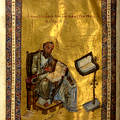Join us for an online conference on Paul and Jewish apocalypticism, on 25–27 October 2021!
I am glad to take part in this conference during my fellowship with Gabriele Boccaccini and other colleagues at the University of Michigan. For more information, please visit the Enoch Seminar’ website. Here is the program:
MONDAY Oct 25, 2021:
8:30am — Informal gathering of participants. You are welcome to join the Webinar for some informal conversation.
9am-11am — Opening session: Paul & Apocalypticism (chair Gabriele Boccaccini)
John J. Collins [download paper] & Emma Wasserman (panelists), Daniele Minisini & Hwankyu Kim [download paper] (shorter contributions)
11:30am-1:30pm — Session One: “The Origin of Evil, the Devil, and the Triumph of God on Evil Forces”
Lisa Bowens [download powerpoint], Matthew Goff [presentation handout], Grant Macaskill [download paper] (panelists)
Lisa Bowens, “Pauline Snapshots: The Origin of Evil, the Devil, and the Triumph of God on Evil Forces”
Paul neither provides a systematic analysis of the origin of evil in his letters, nor elaborates on the origin of Satan. However, he provides snapshots into his understandings of evil’s origin, the figure of Satan and Satan’s activities, as well as God’s triumph through Christ over all evil forces. This brief paper will investigate some of these snapshots and shed light into what traditions inform Paul’s perspectives. Such an exploration will reveal that in several places in the Pauline correspondence Genesis and Genesis traditions, such as those found in the Book of Watchers, play an important role in Paul’s view of the world and evil’s presence in it.
Grant Macaskill, “The Origins and Paradigms of Evil”
It is valid to consider the early Jewish stories about the emergence of sin in the world as accounts of “the origins of evil,” but we need to be careful to recognize that this is one particular identification of their function; we must also consider that they might also function as accounts of how sin works. These are not exclusive possibilities, but they do frame the uptake of the stories into accounts of salvation (such as that of Paul) in different ways. One is about etiology, while the other is about equivalence. If the stories function as accounts of the etiology of evil, then they probably frame “salvation” as an antidote to this problem; if they function as accounts of paradigms of evil—how evil works and how it is to be characterized—they frame salvation as participation in a counter-paradigm. This paper will invite reflection on how these options might relate to each other and how this relationship might explain the hybridization of different stories about the emergence of evil within early Judaism, as well as various interpretative qualities in Paul’s soteriology.
Discussants : Kelley Coblentz Bautch, Jamie Davies, David Burnett, Alexei Sivertsev, Mark Leuchter, Oren Ableman …
2:30pm-4:30pm — Session Two: ” Paul’s Apocalyptic Messianism “
Loren Stuckenbruck, L. Ann Jervis [download paper], James Waddell [download paper] (panelists)
L. Ann Jervis, “Life in Messiah Jesus”
Paul contributes to Second Temple messianic discourse. In particular, the apostle contributes to what J. Thomas Hewitt has called a “species of messiah language” which thinks about solidarity with the Messiah. Union with Christ is central to Paul’s conviction about this Messiah: faith in Jesus Christ means union with Jesus Christ.
I question whether union with Messiah fits with the apocalyptic reading’s claim that Paul works with a Christologically modified two age schema: believers live in the overlap of the new age inaugurated by Christ and the continuing present evil age. I note that Paul never speaks of two ages. Given this lack, and Paul’s repeated affirmation that believers’ existence is in Christ, I propose that Paul understands there to be two modes of existence: one in the present evil age and the other ‘en Christo’. Moreover, union with Messiah is not another way for Paul to talk about the new age. Further, Paul regarded existence in the present evil age and ‘en Christo’ to be mutually exclusive: believers are not partially in Christ and partially in the present evil age.
The matter of how, then, Paul understands sin and physical death is discussed. I concur with apocalyptic interpreters that Paul regards Sin and Death as cosmic powers, but, in distinction from apocalyptic readers, I hear Paul to be convinced that these powers are dead to those who are in union with the one who defeated both.
Discussants : Alexandra Brown, Deborah Forger, Anders Klostergaard Petersen, Anne Kreps, David Burnett, Benjamin Reynolds, Dereck Daschke, Joshua Scott, Clint Burnett, Ron Herms, Oren Ableman, Genevive Dibley
TUESDAY, Oct 26, 2021:
8:30am — Informal gathering of participants. You are welcome to join the Webinar for some informal conversation.
9:00am-11:00am — Session Three: Paul and the Torah in an Apocalyptic Perspective
Matthew Novenson, Mark Kinzer [download paper], Joshua Garroway [download paper], Yael Fisch (panelists)
Discussants : J. Andrew Cowan, Anders Klostergaard Petersen, Ishay Rosen-Zvi, B.J. Oropeza, Dereck Daschke, Jason Staples …
11:30am-1:30pm — Session Four: “Justification, Forgiveness, Judgment, and Salvation”
Magnus Zetterholm, Gabriele Boccaccini [download paper], Jamie Davies [download paper] (panelists)
Magnus Zetterholm
It is a well-known fact that there is a certain ambivalence as to the eschatological destiny of the nations in Jewish tradition. According to some traditions the nations will be destroyed or conquered by Israel, other traditions envisage the future salvation of the Gentiles. In this paper I suggest that Paul draws on both views of the eschatological destiny of the nations, combining a negative view of Gentiles with ideas of their future redemption. By focusing entirely on the salvation of Gentiles as the apostle to the nations Paul appears unique as a Jewish writer not least in presenting a program for how to achieve this and ultimately securing the salvation of the whole world—the Jew first but also the Greek.
Discussants : J. Andrew Cowan, Ishay Rosen-Zvi, B.J. Oropeza, Jason Staples
2:30pm-4:30pm — Session Five: “No longer Jew or Greek, slave or free, male or female: Gender, ethnicity and social status in apocalyptic perspective”
Joseph Angel [download paper], Laura Dingeldein, J. Thomas Hewitt (panelists)
Laura Dingeldein, “No Longer Jew or Greek, Slave or Free, Male or Female: Gender, Ethnicity, and Social Status in Apocalyptic Perspective”
In contributing to the introduction of Session Five, I will articulate and respond to two key questions that we should consider if we want to intelligibly and productively situate Paul’s thoughts on ethnicity, gender, and social status in relationship to the Jewish apocalyptic tradition. The first question is: What does Paul think happens to social distinctions and hierarchies (for example, Jew/Greek, free/slave, male/female), both “in Christ” and in the age to come? The second question is: What range of assumptions and frameworks constitute the Jewish apocalyptic perspective? Ultimately, my hope is that by laying bare our own presumptions about Paul’s thought and the Jewish apocalyptic perspective, our ensuing discussion will be more coherent and productive. For my part in this, I will provide initial responses to the two questions that I pose. With regard to the first question, I do not interpret Paul as promoting the erasure of social hierarchies “in Christ,” but rather as reinforcing, modifying, and elaborating on social hierarchies in his attempt to promote the unification of people with varying and stratified social markers under one banner (“God’s people”). With regard to the second question, following other scholars, I understand two key features of the Jewish apocalyptic perspective to be 1) the expectation of a future age marked by God’s supreme rule, and 2) the assumption that vindication will be given to an elite group of people. I will end my introduction by gesturing to the ways in which I find these features to be relevant to the study of Paul’s views on social distinctions and hierarchies.
Discussants : Thomas Kazen, Ishay Rosen-Zvi, Jeremiah Coogan, Anders Runesson, Ron Herms, Kenneth Atkinson …
WEDNESDAY, Oct 27, 2021
8:30am — Informal gathering of participants. You are welcome to join the Webinar for some informal conversation.
9:00am-11:00am — Session Six: “Paul’s ‘Conversion’ within Judaism: an Apocalyptic Jew and a (Former?) Pharisee”
Gerbern Oegema [download paper] [download handout], Mark Nanos, Jason Maston (panelists)
Mark Nanos, “What was “revealed” to Paul, and why and how does he use this disclosure to instruct the Galatians? Qualifying our source text”
Paul’s famously disclosed his “revelation” in Gal 1, that at an appointed time God “resolved to reveal his Son in me, so that I might proclaim him to the nations….” Prevailing readings neither examine adequately Paul’s purpose for using the language of revelation here, nor the fact that he still identifies himself in terms of “the traditions of my fathers,” almost certainly denoting continued Pharisaic self-understanding. The familiar translations and interpretive paradigms were developed by interpreters who probably never considered constructing Paul within Second Temple Judaism, except in terms of the background from which he came, from which he converted away, and that he viewed in negative binary terms with his post-“conversion, Christian” identification, values, way of life, teaching, and so on. If we do our work guided by their sensibilities and interpretive constructions, we risk failing to read Paul anew when we place “him” on the map drawn based on “other” contemporary Jewish ways of living and reasoning, or any other conceptual map, for that matter. We should consider hypotheses about the meaning of the source material we will use for comparison with a new set of expectations and ways to construe the possibilities for evaluating what Paul meant as well as how he lived with respect to Jewish norms, not least the practice and promotion of Torah (from his disclosures of Pharisaic orientation; cf. Phil 3:5), but also what it was that he was “zealous” for before and after this change of orientation to the Jesus confessing groups. By contextualizing how and why he uses this language—which revolves around his changed position on how to include non-Jews as sons of Abraham according to Torah and revelation—I hope to contribute to careful qualification of the textual details we draw from in order to answer the broader question of this session: “Paul’s ‘Conversion’ within Judaism: an Apocalyptic Jew and a (Former?) Pharisee.”
Jason Matson, “Paul’s ‘Conversion’ in Context: Initial Thoughts on a Comparison between MMT and Paul”
At the age of sixteen, Josephus reports, he ‘determined to gain personal experience’ with the main Jewish groups (Pharisees, Sadducees and Essenes) in order that ‘after a thorough investigation’ he would ‘be in a position to select the best’. After enduring rigorous training, he decided the experience was not sufficient so he spent three years in the desert with a certain Bannus. Finally, at the age of nineteen, he decided to ‘govern my life by the rules of the Pharisees’ (Life 10–12; trans. Thackeray). Josephus’ presentation raises an interesting question: how would one’s understanding and experience be different if a person moved from one Jewish group to another? In this presentation, I propose imagining how someone might have reacted to reading MMT and what would need to change if they decided to follow the advice of the sender. I explore three topics from MMT: the interpretation of scripture, the perspective on Torah observance, and community formation. Using these topics I turn to Paul to see how his perspectives might have changed.
Discussants: Yael Fisch, Deborah Forger, Alexei Sivertsev, Michael Langlois …
11:30am-1:30pm — Session Seven: “Paul within Paganism (Paula Fredriksen, chair)”
Jennifer Eyl, Stephen Young [download presentation aid][download paper], Matthew Sharp [download paper], Matthew Thiessen [download paper] (panelists)
Stephen Young, “Paul’s Pagan Mythmaking: Christ the Subordinate Divine Warrior”
Biblical scholars often focus on “backgrounds” in the Hebrew Bible and wider Ancient West Asian literature for passages in the New Testament where Christ and the high God are depicted as divine warriors. While these usual-suspect texts certainly were literary resources for Paul, this typical approach reproduces the Judaism versus Hellenism dichotomy, particularly because of what it neglects. Paul’s gentile addressees were not Jewish scribes who read the Jewish prophetic and revelatory writings that feature such divine warrior imagery. But the world of these gentiles was filled with numerous myths about hierarchies of Greek and Roman deities that did battle, often on behalf of a higher god, and whose victories resulted in their cosmic authority and ability to dispense benefits to their subjects. Paul’s letters present Christ as a warrior for the high Jewish God who defeats enemies, receives cosmic authority, and dispenses benefits like pneuma and resurrection to his gentile subjects. And his eschatological mythmaking about Christ unfolds within these recognizable ‘pagan’ mythic scripts.
Discussants : Stanley Stowers & Paula Fredriksen (respondents); Alexander Chantziantoniou, Anne Kreps, David Rudolph, Kenneth Atkinson …
2:30pm-4:30pm — Wrap-up session: what’s next? Was Paul supersessionist? Did the covenant in Christ replace the Torah and was added to Torah?
The Participants and the Fellows of the Frankel Institute
 En
En Fr
Fr






